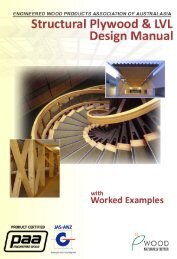Facts About Particleboard and MDF - Engineered Wood Products ...
Facts About Particleboard and MDF - Engineered Wood Products ...
Facts About Particleboard and MDF - Engineered Wood Products ...
You also want an ePaper? Increase the reach of your titles
YUMPU automatically turns print PDFs into web optimized ePapers that Google loves.
a hole bored to give a good fit <strong>and</strong> a self-tapping screw is then driven into it. This type of fastener serves the<br />
dual purpose of providing a secure but easily demountable knockdown fixing.<br />
Other forms of special fastening devices that provide a high degree of resistance to withdrawal are those that<br />
are inserted into a hole pre-drilled through the board <strong>and</strong> either partly deform or obtain anchorage on the<br />
back of the board when tightened. Devices that obtain anchorage on the back of the board are the spring <strong>and</strong><br />
gravity toggle type. With the gravity type, a portion of the device is held parallel to the screw during insertion<br />
<strong>and</strong> drops perpendicular to the screw when passed through the board. The screw is tightened to obtain a firm<br />
anchorage. The spring toggle type normally has two sprung metal wings which are held closed during<br />
insertion <strong>and</strong> then open when passed through the board. Again the screw is tightened to obtain a secure<br />
anchorage. The hole size necessary to enable insertion of a toggle device is larger than the screw or shank<br />
diameter <strong>and</strong> thus lateral location will tend to be less rigid than with devices that exp<strong>and</strong> or deform.<br />
Where edge fixings are required to support heavy loads, such as hinge fixings for large doors, the use of a<br />
wood lipping is recommended. The lipping should be about 18 mm thick for large doors, although 12 mm<br />
would be suitable.<br />
Knock-down Fastening<br />
Only permanent fixing should be made directly into <strong>Particleboard</strong> <strong>and</strong> <strong>MDF</strong>. Where demountability <strong>and</strong> reassembly<br />
will be required, the use of special inserts or knockdown fastenings is advised.<br />
Reference has been made in previous section to the use of inserts with conventional screw fixing <strong>and</strong> these<br />
notes give a general description of the range of devices specifically made for knockdown applications.<br />
Knockdown or assembly fastenings can be broadly divided into three groups; concealed, surface <strong>and</strong> flush<br />
fitting.<br />
Concealed fastenings are often based on press-stud action. These consist of an insert fixed into a pre-boxed<br />
hole in one component <strong>and</strong> a dowel fixed into a pre-boxed hole in the other. The insert is either ridged or<br />
lipped on the inside face <strong>and</strong> locates into grooves in the dowel when the two parts are brought together.<br />
With some types, the dowel is separate <strong>and</strong> locates into similar inserts fixed into each component <strong>and</strong><br />
provide a neat <strong>and</strong> precise joint.<br />
Surface fittings are widely used where visible fastenings are acceptable <strong>and</strong> economy important. They vary in<br />
the type of locating devise used but all are fixed directly onto the surface of each component <strong>and</strong> do not<br />
necessitate any machining. They consist of two parts which locate <strong>and</strong> are held together either by locking,<br />
screwing or wedging.<br />
Locking <strong>and</strong> wedging devices are usually metal <strong>and</strong> screw devices either plastic or metal. Some are quite<br />
large, but they all tend to be less expensive than other methods.<br />
Precise location of components may be made easier with some of these fasteners if dry dowels are<br />
incorporated in the joint.<br />
A number of flush fitting devices are available <strong>and</strong> they vary widely in their design <strong>and</strong> method of fastening.<br />
Generally, these types of fastener require more machining of the components to be joined <strong>and</strong> tend to be<br />
more expensive but they give a stronger joint.<br />
The range of fasteners available for knockdown applications is wide <strong>and</strong> varied. The type of applications,<br />
visual appearance <strong>and</strong> cost will influence the user's choice, so it is not possible to make specific<br />
recommendations on suitable fasteners.<br />
31

















